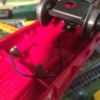The 1983/84 Hudson was one of the first pieces made in Mt. Clemens upon return. I am not sure about the Turbine from that year but I know the new SD's were made in Mexico.
I have read statements that the 8404 turbine was made in Mexico, and statements that is was made in the USA. Mine has all its packaging and paperwork. I believe those materials say it is made in the USA.
I'm going to do some checking on this one. I think the 8404 Turbine (perhaps my all-time favorite MPC locomotive) is one of those pieces that they planned to make in Mexico, and had the vast majority of parts produced there with that in mind. But ultimately, final assembly and pack-out were done here in the states. Don't quote me on that just yet. I'm fairly certain the boxes say Made in Mexico.
Regarding early MPC with Timken trucks:
As has already been posted, the trucks were modified to accept the needlepoint axles.
I'd have to look at one to be certain, I think they may have also been modified to use a plastic coupler locking arm.
Several early MPC cars are known to have come with postwar plastic trucks. I think the early 9150 Gulf tanker is one example.
Yes, the coupler armature -- "plastic locking arm" -- was one of the things that MPC modified.
And you're absolutely correct about 9150 Gulf Tank Cars coming with leftover postwar AAR trucks. I forgot about this one. These were the earliest versions produced, and are usually the scarce variations that have been painted white over leftover postwar orange tank car bodies.
So besides the 9160 Illinois Central Porthole Caboose and the 9150 Gulf Tank Car, what other cars used the leftover AAR trucks? I can only recall one more -- the infamous 6560 Bucyrus Erie Crane Car from 1971. Please let me know if you see any others!
Regards,
Todd






